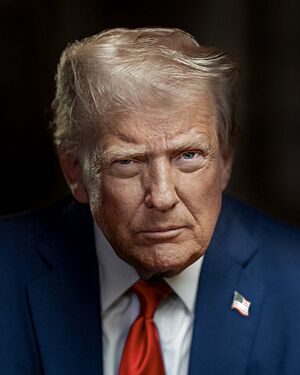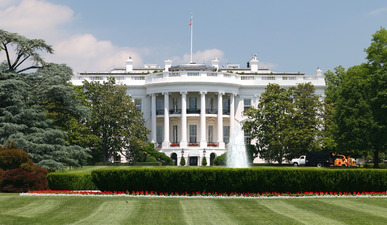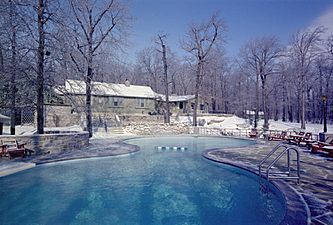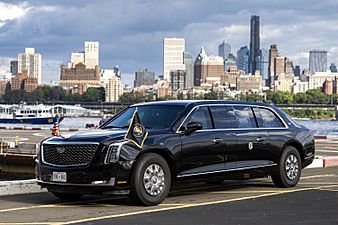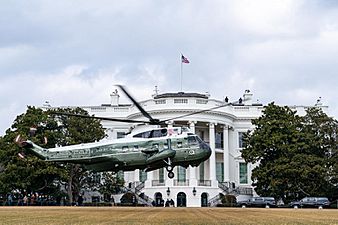President of the United States facts for kids
Quick facts for kids President of the United States |
|
|---|---|

|
|

|
|
|
|
| Style |
|
| Abbreviation | POTUS |
| Member of | |
| Residence | White House |
| Seat | Washington, D.C. |
| Appointer | Electoral College or via succession |
| Term length | Four years |
| Constituting instrument | Constitution of the United States (1789) |
| Formation | March 4, 1789 |
| First holder | George Washington |
| Succession | Line of succession |
| Salary | $400,000 per year |
The president of the United States (often called POTUS) is the main leader of the United States. The president is both the head of state (the symbolic leader of the country) and the head of government (the person in charge of running the government). They lead the executive branch of the U.S. government and are the commander-in-chief of the U.S. military.
Since the first president, George Washington, took office in 1789, the power of the presidency has grown. Today, the president is one of the most powerful political figures in the world. They lead a nation with a huge economy and a strong military.
Article II of the U.S. Constitution created the executive branch and gave the president power. This power includes making sure federal laws are followed and appointing important government officials. The president is also in charge of U.S. foreign policy, dealing with other countries, and leading the world's most expensive military.
The president also plays a big role in making laws and policies for the country. The Constitution gives the president the power to sign or veto laws passed by Congress. Presidents often lead their political parties and work to get their ideas passed into law. They also use executive orders and appoint judges to shape policies.
The president is chosen indirectly by the Electoral College for a four-year term. The vice president is also elected at the same time. A president can only be elected twice, thanks to the Twenty-second Amendment (1951). If a president leaves office early (due to death or resignation), the vice president takes over. So far, 45 people have served as president. Donald Trump is the 47th and current president, having taken office on January 20, 2025.
Contents
How the Presidency Started
Early Days of the U.S.
In July 1776, the Thirteen Colonies in America decided to become independent from British rule. They signed the United States Declaration of Independence. To work together against the British, they created a first constitution called the Articles of Confederation. This document created a central government, but it was very weak. It couldn't collect taxes or make strong laws.
Under the Articles, there was a "President of the United States in Congress Assembled." This person was mostly a moderator for meetings and had no real executive power.
After the Revolutionary War ended in 1783, the states faced many problems. Their economies were struggling, and there was unrest, like Shays' Rebellion. These events showed that the Articles of Confederation were not strong enough. A stronger national government with a powerful leader was needed.
Creating the President's Job
In 1787, leaders met at the Constitutional Convention in Philadelphia. They wanted to create a new, stronger government. They looked at how their own states were run. Most states had weak governors and strong legislatures. New York was an exception, with a strong governor.
Through many discussions, the job of the president, as described in the U.S. Constitution, was created.
Presidential History
From 1789 to 1933
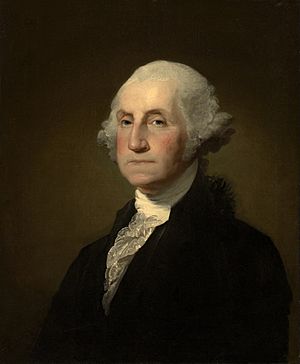
As the first president, George Washington set many important examples. He decided to step down after two terms, which helped calm fears that the U.S. would become a monarchy. This became a tradition for many years.
Early presidents like Thomas Jefferson, James Madison, and James Monroe also served two terms. In 1828, Andrew Jackson became president. He was different from earlier leaders and wanted to make the presidency stronger. However, after him, the office became weaker again for a while.
Abraham Lincoln's leadership during the Civil War made him one of the greatest presidents. The war made the presidency very powerful. Lincoln was the first president since Jackson to be re-elected. After Lincoln, Congress became powerful again.
Later, Theodore Roosevelt greatly changed the presidency. He used his power to break up large companies, protect nature, and improve workers' rights. He made the president's personal character important. Woodrow Wilson led the U.S. during World War I.
The Modern Presidency

The presidency became even stronger starting in 1933 with Franklin D. Roosevelt. His "New Deal" programs greatly expanded the government. His staff grew, and the Executive Office of the President was created. Roosevelt was elected four times, leading the U.S. through the Great Depression and World War II. This made the U.S. president a global leader.
After Roosevelt, presidents like Harry Truman and Dwight D. Eisenhower served two terms during the Cold War. They were seen as leaders of the "free world."
After the Vietnam War and the Watergate scandal involving Richard Nixon, Congress tried to limit presidential power. However, presidents continued to use their power, especially through executive orders and appointing judges. In recent times, the U.S. has become more politically divided.
What the President Does
Making Laws
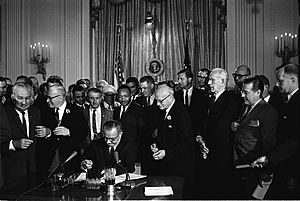
Even though Congress makes laws, the president has a big say. The president's most important power is to veto any bill passed by Congress. If the president vetoes a bill, Congress needs a special two-thirds vote in both houses to make it a law anyway. This is very hard to do.
The president has three choices when a bill comes to them:
- Sign the bill within ten days (not counting Sundays). It becomes law.
- Veto the bill within ten days and send it back to Congress with their reasons. It does not become law unless Congress overrides the veto.
- Do nothing for ten days. If Congress is still meeting, the bill becomes law. If Congress has ended its session, the bill does not become law (this is called a pocket veto).
Presidents also help set the country's agenda. They suggest new laws and policies to Congress, often during the annual State of the Union address. They can also try to convince members of Congress to support their ideas.
Running the Government
The president is the head of the executive branch, which has over four million employees, including the military.
Presidents appoint many people to government jobs, like Cabinet members and Ambassadors. Many of these appointments need to be approved by the Senate.
Presidents can also issue special orders, like executive orders, to manage the government. These orders have the force of law, but courts can review them, and Congress can overturn them with new laws.
Foreign Affairs
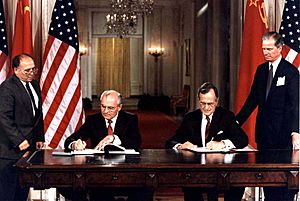
The president is the main person in charge of how the U.S. deals with other countries. The Constitution says the president "receives Ambassadors," which means they have a lot of power over foreign policy. They appoint U.S. ambassadors and negotiate agreements with other countries. These agreements, called treaties, need to be approved by two-thirds of the Senate.
Presidents today often meet directly with leaders from other countries, which makes their role in foreign affairs even stronger.
Commander-in-Chief
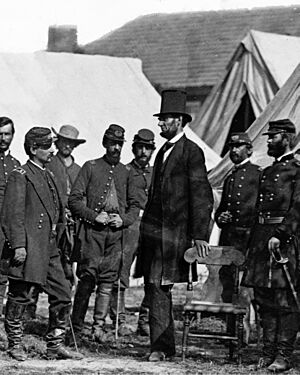
One of the president's most important jobs is being the commander-in-chief of the U.S. military. While only Congress can declare war, the president is responsible for leading the military.
The Constitution limits the president's military powers. For example, Alexander Hamilton explained that the president commands the military, but Congress declares war and raises armies.
In modern times, Congress passed the War Powers Resolution to try and limit how long presidents can send troops into conflict without Congress's approval. However, presidents have often sent troops without a formal declaration of war.
Presidents have varied in how much they get involved in military details. George Washington showed that the military must follow civilian leaders. Abraham Lincoln was very involved in the strategy of the American Civil War. Today, the military is managed by the Department of Defense, under the president's direction.
Judicial Powers
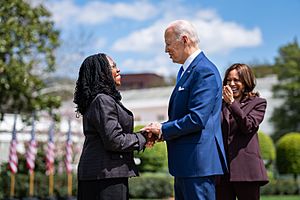
The president chooses federal judges, including those for the Supreme Court of the United States. These choices must be approved by the Senate. Getting Senate approval can be a big challenge if the president wants to appoint judges with certain views.
Presidents can also grant pardons, which forgive people for crimes. For example, Gerald Ford pardoned Richard Nixon after Nixon resigned. Presidents sometimes grant pardons just before leaving office, which can be controversial.
Presidents also have "executive privilege," which allows them to keep some communications private. This helps them get honest advice. However, the Supreme Court has ruled that this privilege is not absolute, especially in cases involving criminal investigations.
Another power is the "state secrets privilege," which lets the president keep information secret if releasing it would harm national security. This power has been used more often in recent years.
Leadership Roles
Head of State
As the head of state, the president represents the U.S. to its own people and to the world. For example, when a foreign leader visits, the president hosts a special welcome ceremony and a formal dinner.
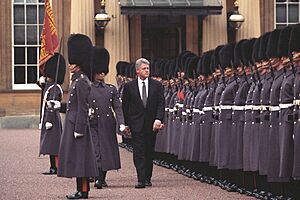
The president also performs many ceremonial duties. For instance, William Howard Taft started the tradition of throwing out the ceremonial first pitch at baseball games. Every president since Theodore Roosevelt has been the honorary president of the Boy Scouts of America.
Other traditions include the White House egg rolling for children and the annual "pardoning" of a turkey before Thanksgiving.
Presidents also give advice to their successors during the transition period. Ronald Reagan started the tradition of leaving a private message for the incoming president on the Oval Office desk.
Many people see the president as a celebrity. The way presidents are presented to the public is often carefully managed. This can lead to people having very high expectations for what a president can achieve.
Head of Party
The president is usually seen as the leader and main spokesperson for their political party. Their success in elections often affects how well other candidates from their party do. However, there can be disagreements between a president and members of their own party in Congress.
Global Leader
Since the 20th century, the U.S. has become a superpower, and its economy is the largest in the world. Because of this, the president is often seen as a global leader, and sometimes the most powerful political figure in the world. The U.S. leads important groups like NATO, which has led to the president being called the "leader of the free world."
Becoming President
Who Can Be President?
To be president, a person must:
- Be a natural-born citizen of the U.S.
- Be at least 35 years old.
- Have lived in the U.S. for at least 14 years.
There are also rules that can prevent someone from being president, such as if they were removed from another public office through impeachment and disqualified. Also, someone who rebelled against the U.S. after swearing an oath to the Constitution cannot be president, unless Congress votes to allow it.
Previous Experience
Most presidents have held other important jobs before, like governor, U.S. senator, Congressman, general, or Cabinet member. The most common past job for presidents is a lawyer. Many presidents have also earned a college degree.
Campaigns and Elections
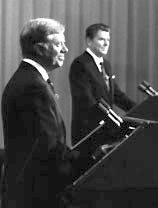
The journey to becoming president starts with primary elections, where the two main political parties choose their best candidate. Then, at national conventions, the party officially names its presidential and vice presidential candidates.
Candidates then take part in televised debates and travel across the country to share their ideas and ask for votes and donations. They often focus on winning "swing states," where the election could go either way.
How Votes Are Counted
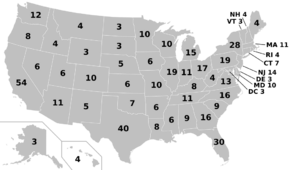
The president is not chosen directly by popular vote. Instead, they are elected by the Electoral College. Each state gets a certain number of "electors" based on its population. In most states, the candidate who wins the popular vote in that state gets all of its electoral votes.
About six weeks after the election, the electors meet in their state capitals to cast their votes for president and vice president. These votes are then sent to Congress. In early January, Congress counts the electoral votes. To win, a candidate needs at least 270 out of 538 electoral votes.
If no candidate gets enough electoral votes, the House of Representatives chooses the president. This has happened twice in U.S. history: in 1800 and 1824.
Inauguration Day
The president's four-year term begins at noon on January 20, the year after the election. This day is called Inauguration Day.
Before becoming president, the person must say the presidential Oath of Office, which is in the Constitution:
I do solemnly swear (or affirm) that I will faithfully execute the Office of President of the United States, and will to the best of my ability, preserve, protect, and defend the Constitution of the United States.
Presidents usually place one hand on a Bible and add "So help me God" at the end. The Chief Justice usually gives the oath.
During and After the Presidency
Term Limits
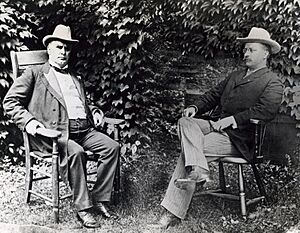
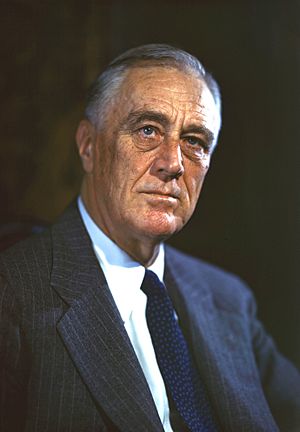
George Washington set a tradition by serving only two terms. This tradition was followed for many years. However, in 1940, Franklin Roosevelt was elected to a third term, and then a fourth, during the Great Depression and World War II. He died shortly into his fourth term.
Because of Roosevelt's long presidency, the Twenty-second Amendment was passed in 1951. It limits a person to being elected president only twice. If someone serves more than two years of another president's term, they can only be elected once more.
If the President Can't Serve
If the president dies, resigns, or is removed from office, the vice president becomes president. This has happened several times due to a president's death, and once due to a president's resignation.
If both the president and vice president cannot serve, Congress has a plan for who takes over. The line of succession goes from the Speaker of the House, then the president pro tempore of the Senate, and then to the heads of the president's Cabinet departments, starting with the Secretary of State.
The Twenty-fifth Amendment also allows a president to temporarily give their powers to the vice president if they are unable to do their job, for example, during surgery. This has happened a few times.
Removal from Office
The Constitution allows for the president to be removed from office for "treason, bribery, or other high crimes and misdemeanors." The House of Representatives can vote to impeach (accuse) a president. If the House impeaches, the Senate then holds a trial. A two-thirds vote in the Senate is needed to convict and remove the president from office.
Three presidents have been impeached by the House: Andrew Johnson, Bill Clinton, and Donald Trump (twice). None of them were convicted by the Senate. Richard Nixon resigned before the House could vote to impeach him.
Pay and Benefits
Since 2001, the president's yearly salary has been $400,000. They also get an expense allowance, a travel account, and an entertainment account. Congress sets the president's salary, but any changes don't take effect until the next presidential term.
Where the President Lives
The White House in Washington, D.C. is the president's official home. Every president since John Adams (in 1800) has lived there. It's also known as the "President's Palace" or "Executive Mansion." Theodore Roosevelt officially named it the White House in 1901. The government pays for official events, but the president pays for personal expenses like food and dry cleaning.
Camp David in Frederick County, Maryland, is the president's country retreat. It's a quiet place often used to host foreign leaders.
The President's Guest House, also known as Blair House, is next to the White House. It's used for official guests and as a backup residence for the president.
- Presidential residences
-
White House, the official residence
-
Camp David in Frederick County, Maryland, the official retreat
-
Blair House, the official guest house
How the President Travels
For long-distance air travel, the president uses one of two special Boeing 747 planes, known as Air Force One when the president is on board. For shorter trips, the president uses U.S. Marine Corps helicopters, called Marine One when the president is aboard.
For ground travel, the president uses the presidential state car, an armored limousine often called "The Beast." The Secret Service operates these vehicles. The president also has armored buses for tours.
- Presidential transportation
-
The presidential plane, called Air Force One when the president is on board
-
The presidential helicopter, known as Marine One when the president is aboard
Protection

The U.S. Secret Service protects the president and their family. They use special Secret Service codenames for security.
After Leaving Office
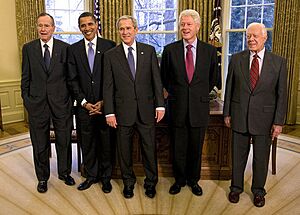
Many former presidents continue to be active after their term ends. Some, like William Howard Taft, even held other important jobs (Taft became a Chief Justice). Others, like Jimmy Carter, became global human rights advocates and helped with international issues.
Former presidents often help current presidents. For example, George W. Bush and Bill Clinton worked together on humanitarian efforts after natural disasters.
Former presidents also receive a pension, medical care, and Secret Service protection for life.
Presidential Libraries
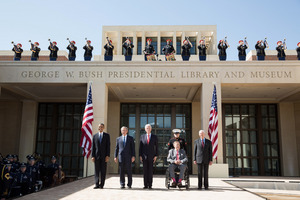
Every president since Herbert Hoover has created a presidential library. These libraries store their papers, records, and other important documents. They are managed by the National Archives and Records Administration (NARA). Many presidential libraries also contain the graves of the presidents they honor, like the Harry S. Truman Presidential Library and Museum and the Ronald Reagan Presidential Library and Museum.
Political Parties
Political parties have been a big part of American politics for most of its history. Even though the Founding Fathers didn't plan for them, parties quickly formed.
George Washington was the only president who was not part of any political party. Since then, every president has belonged to a party. Since 1869, all presidents have been either a Republican or a Democrat.
Here's a list of presidents by their political party when they first took office:
Timeline of Presidents
This timeline shows the presidents and their political parties when they started their terms.
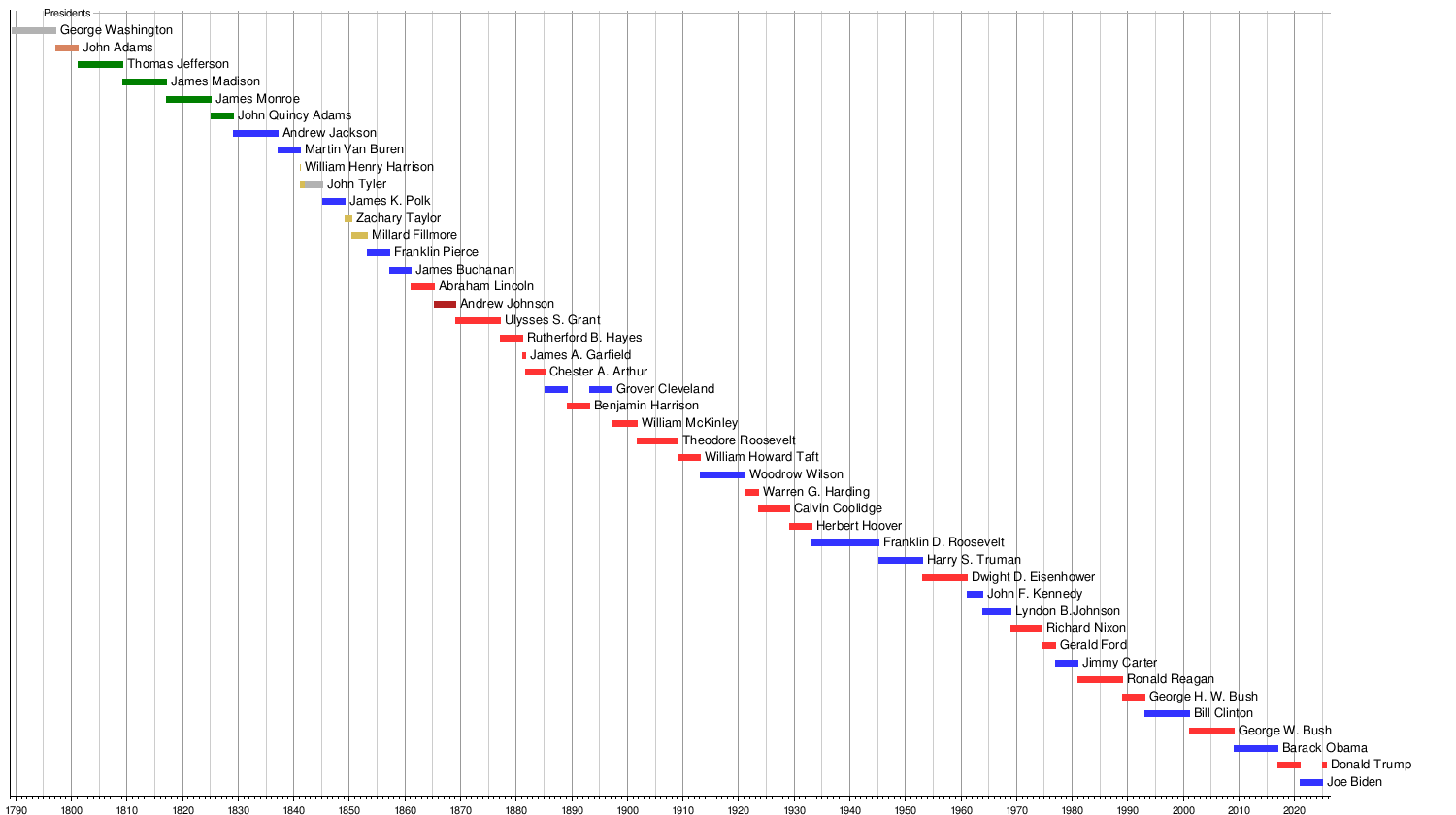
See also
 In Spanish: Presidente de los Estados Unidos para niños
In Spanish: Presidente de los Estados Unidos para niños
- Outline of American politics


